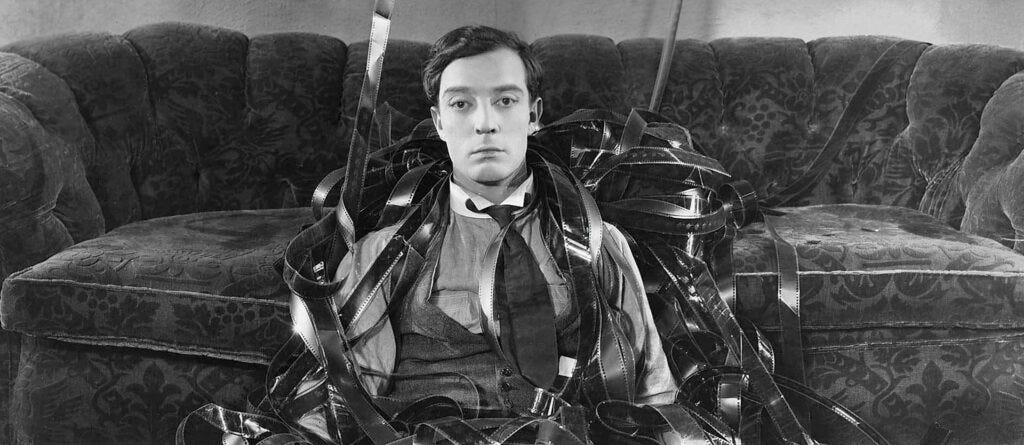Buster Keaton's Comic Brilliance
Visual humor from the silent-era cinema, like other forms of humor (stand-up, sitcom, etc.), is hard to dissect because of the adage that explaining a joke ruins the joke. Like a metaphor that defines something through an oblique comparison to something else, comedy functions in this angled alignment. Therefore, in looking at what makes Buster Keaton's visual humor unique compared to his contemporaries like Chaplin and Lloyd, it’s necessary to discuss Keaton's deadpan reactions that earned him nicknames like the 'Great Stone Face'.
Keaton grew up in a Vaudeville performance family. From a young age, he quickly learned the dynamics of performing visual gags with his body on stage, which included stunts that appeared dangerous (and sometimes were in fact). In explaining his childhood, Keaton commented on his father physically abusing him every time he smiled on stage and broke the illusion of the show to the audience: “If I should chance smile, the next hit would be a good deal harder.” “He kept after me, never let up, and in a few years it was automatic. Then when I’d step on stage or in front of a camera, I couldn’t smile…”
Asked whether pain, not pleasure, is at the bottom of most successful humor, Keaton responded: “Yes, I’m afraid I do to a certain extent, a great deal of it because an audience will laugh at things happening to you, and they certainly wouldn’t laugh if it happened to them.” In one of the earliest texts on silent comedy actors, James Agee in his article "Comedy's Greatest Era" indicated that “there was in his comedy a freezing whisper not of pathos but of melancholia.” In this way, Keaton's comedy functions in a similar vein to the sad clown paradox, which is the use of outward lightheartedness to mask inner anxieties and contradictions. Think end of Act I Pagliacci, in which Canio has to assume the clown mask and perform after finding out his wife is unfaithful.
Keaton's stone-cold face was able to tap into the function of the mask in commedia dell'arte; with a mask projecting a singular, unchanging expression, the character's emotions are forced through the body and its interactions with the environment, which creates a juxtaposition/incongruity between the face and everything else. One of the oldest forms of thinking about humor is through the incongruity theory, which is simply the humor derived from juxtaposing two incongruous objects. With origins back to Aristotle and possibly beyond, this theory was forwarded by Kant, Bergson, and other important philosophers over time. Rather trying to simplify and summarize their points, I think these gifs of Keaton are able to provide more succinct demonstrations of the incongruity between his stone-cold face and everything else around him:
In Walter Kerr's The Silent Clowns, he points that as “most [silent comedians] regarded the physical world as an obstacle to be overcome or evaded, by ingenuity or grit. Keaton felt otherwise. He knew all about obstacles, of course. But treacherous as the universe might be, Keaton trusted it.” As can be seen with the clips above, Keaton allows his body to be taken by the physical world around him and instead of responding with a dazed or exaggerated facial expression indicating the bizarreness, he accepts it, creating the incongruity between his body/face (mostly non-emotive) and the world (chaotic and requiring a human reaction).
Keaton's stunts regularly appear online because of their uniqueness to an era of cinema long forgotten. Although most of the 'silent-era clowns' are all but lost, Chaplin's films have survived because of his electric character(s) aided by excellent storytelling and Keaton's stunts (but not necessarily his films) break through the noise and grain of his period because of his ability in mastering this incongruity between face and world. In short, it’s the metaphor that no matter the amount of chaos surrounding us, we prevail head-first intact.
Recommended viewing:
One Week (1920)
Neighbors (1920)
Sherlock Jr. (1924)
The General (1926)

